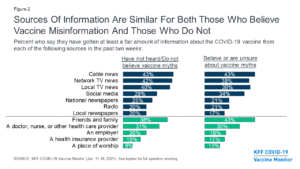There have been a lot of conversations around the COVID-19 vaccines lately. Thankfully, they are here and are in the process of being rolled out and are working to curve and ultimately end the pandemic.
The Biden Administration has also promised to increase the number of vaccines and “is giving states an approximate 17 percent boost in vaccines following complaints of shortages.” Johnson & Johnson requested and was granted emergency use authorization (EUA) for its single dose COVID-19 vaccine. The company expects to distribute enough vaccines to vaccinate 20 million Americans by the end of March 2021. Despite this, the Biden Administration has cautioned that it will be months before anyone who wants to receive the COVID-19 vaccine(s) is able to.
Normally, before a vaccine comes to market, companies run experiments on the vaccine. Now, because of the high demand for the vaccine, those experiments are running alongside those that are receiving the vaccine. Britain scientists are exploring what happens when the COVID-19 vaccines are mix matched. For example, person A receives the Pfizer vaccine and then the Moderna vaccine and vice versa. The vaccine’s current guidance states that they “aren’t interchangeable but can be mixed if the same kind isn’t available for the second dose or if it’s unknown what was given for the first shot.”
 Despite the experiments, the unknown facts about the COVID-19 vaccine, the cautions that have been rolled out about gathering and the need to continue to social distance and wear a mask; some Americans do not believe in and/or have misinformation about the COVID-19 vaccines. The Kaiser Family Foundation (KFF) has been gathering research about the vaccines and what different groups – Hispanics and those that live in Rural America – think about them, their responses to the vaccine, where they are getting their information from and who they trust with this kind of information via its vaccine monitor. The research allows experts to understand the pushback to have a better educational conversation. According to the vaccine monitor, the top four media platforms people are getting information about the COVID-19 vaccines is cable news, network TV news, local TV news and social media. The figure to the right ranks the different platforms and shows the percentage of people that have not heard and/or do not believe in the vaccine myths vs the percentage of people that believe and/or are unsure of the vaccine myths.
Despite the experiments, the unknown facts about the COVID-19 vaccine, the cautions that have been rolled out about gathering and the need to continue to social distance and wear a mask; some Americans do not believe in and/or have misinformation about the COVID-19 vaccines. The Kaiser Family Foundation (KFF) has been gathering research about the vaccines and what different groups – Hispanics and those that live in Rural America – think about them, their responses to the vaccine, where they are getting their information from and who they trust with this kind of information via its vaccine monitor. The research allows experts to understand the pushback to have a better educational conversation. According to the vaccine monitor, the top four media platforms people are getting information about the COVID-19 vaccines is cable news, network TV news, local TV news and social media. The figure to the right ranks the different platforms and shows the percentage of people that have not heard and/or do not believe in the vaccine myths vs the percentage of people that believe and/or are unsure of the vaccine myths.
 The country’s current strategy is to vaccinate its first responders and the elderly. The elderly are having some problems receiving the vaccine. KFF’s latest report shows that support systems, friends and family are key to assisting and ensuring the elderly receive their vaccines. From transportation, being technology savvy and getting updates on when and where the vaccines are available and making their appointments to receive both vaccines. It’s still unknown how far these hurdles are impacting the elderly overall.
The country’s current strategy is to vaccinate its first responders and the elderly. The elderly are having some problems receiving the vaccine. KFF’s latest report shows that support systems, friends and family are key to assisting and ensuring the elderly receive their vaccines. From transportation, being technology savvy and getting updates on when and where the vaccines are available and making their appointments to receive both vaccines. It’s still unknown how far these hurdles are impacting the elderly overall.






